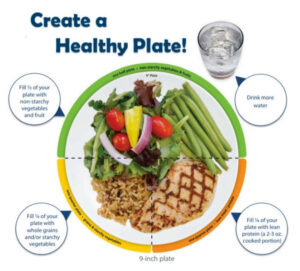Healthy Eating Tips

Planning your meals can seem complicated when you think about calories, food groups, protein, fiber, and serving sizes. You can simplify it by making the Perfect Plate.
Creating the Perfect Meal
Fill ½ Your Plate with Vegetables
- Most of your meals should be based around non-starchy vegetables such as broccoli, tomatoes, and bell peppers. Different color vegetables provide a variety of cancer-fighting nutrients (phytonutrients).
- Vegetables can be both fresh and frozen. Be cautious with canned produce, looking at sodium, seasonings, and preservatives.
- This section would not include starchy vegetables such as corn, beans, potatoes, or peas.
Add Lean Protein to ¼ of Your Plate
- Include plant-based sources such as beans, legumes, nuts, seeds, and soy when possible. Other lean protein sources are chicken, turkey, fish, eggs, and dairy.
- Don’t be afraid of soy foods (e.g., tofu, soy milk, soy nuts, edamame). Research suggests that 1-2 cups of soy foods per day is safe and a good source of protein, healthy fats, and cancer-fighting nutrients (phytonutrients). Soy foods are not associated with human-made estrogen and do not affect hormone-based cancers. Avoid soy supplements and products containing soy protein isolate.
- Eat fatty fish rich in omega-3 fatty acids 2-3 times per week. Sources include arctic char, herring, salmon, bluefin tuna, whitefish, cobia, anchovies, and sardines. These fish contain anti-inflammatory omega 3 fatty acids. Avoid large amounts of King Mackerel, shark, big-eye tuna, marlin, swordfish, and tilefish (from the Gulf of Mexico) due to high mercury content.
- This section does not include processed meats such as pepperoni, salami, bologna, ham, hot dogs, bacon, and sausage. These are meats that are smoked, cured, salted, or contain added preservatives.
- Limit red meat to no more than 12 to 18 ounces per week. Serving size = 3oz (size of a deck of cards). This includes beef, lamb, pork, and game meats. Avoid ribs, steaks with marbling, and full-fat ground beef as much as possible due to their high fat content.
Add a Carbohydrate to the other ¼ of Your Plate
- Carbohydrates include whole grains, starchy vegetables, dairy, and fruit.
- Choose whole grains instead of refined grains. Examples include whole grain breads or pastas (must have the word “whole” and not “enriched”), oats, barley, quinoa, popcorn, brown rice, bulgur, millet, and buckwheat. Starchy vegetables include corn, beans, potatoes, sweet potatoes, lentils, and peas.
- Dairy foods are a great source of calcium, vitamin D and protein. Pick products with less added sugars and higher protein contents such as Greek yogurt, cottage cheese and kefir.
- Fruits are high in vitamins, minerals, and fiber. Choose whole fruits over fruit juice, canned fruit in syrup, and dried fruit.
Making Healthy Choices
- Eat fewer processed foods, or foods that do not look like their original form. Many processed foods are packaged and require a nutrition label. Avoid large amounts of dietary supplements. Our bodies prefer foods in the form of
whole foods, that’s how we digest and absorb nutrients like protein, calories, and cancer-fighting nutrients (phytonutrients). - Limit alcohol to no more than 1 serving per day for women and 2 for men. Ideally, avoid alcohol all together.
- Limit added sugars and sugar-sweetened beverages. These types of sugar that don’t add nutritional value. All the cells in your body need glucose (sugar) for energy. Feed your body nourishing sugars such as fruits, starchy vegetables, beans, legumes, and whole grains.
My Healthy Plate Recommendations
| Food Group | Foods to Choose | Foods to Avoid |
| Vegetables (½ plate) |
|
|
| Proteins (¼ plate) |
*Contains protein and carbohydrates |
|
| Carbohydrates (¼ plate) |
*Contains protein and carbohydrates |
|
| Fats |
|
|
| Beverages |
|
|
Relaxation Tips:
- Do some deep breathing exercises.
- Aromatherapy: Put a few drops of peppermint oil on your wrist and breathe in.
- Participate in yoga to ease your mind and strengthen your body.
- Utilize apps for meditation such as “Calm” or “Head Space”.
- Listen to music to reduce anxiety and stress.
- Exercise to get your body moving to assist with digestion.
- Complementary therapies such as massage, acupuncture, or acupressure.
Top 5 Songs to Reduce Anxiety and Stress
- “Weightless” by Marconi Union
- “Electra” by Airstream
- “Mellomaniac (Chill Out Mix)” by DJ Shah
- “Watermark” by Enya
- “Strawberry Swing” by Coldplay
